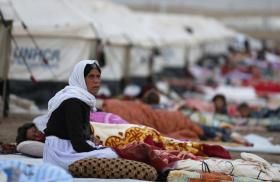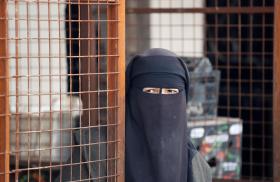
- Policy Analysis
- PolicyWatch 2376
Rehabilitation and Reintegration of Returning Foreign Terrorist Fighters

Part of a series: Counterterrorism Lecture Series
or see Part 1: U.S. Efforts against Terrorism Financing: A View from the Private Sector
On the margins of the White House Summit on Countering Violent Extremism (CVE), global leaders in efforts to rehabilitate radicalized fighters gathered at the Institute to share their insights into what works -- and what doesn't.
On February 20, Gilles de Kerchove, Jacob Bundsgaard, Doug Stone, and Matthew Levitt addressed a Policy Forum at The Washington Institute. Kerchove is the European Union Counterterrorism Coordinator. Bundsgaard is Lord Mayor of Aarhus, Denmark, and a prominent player in the city's widely known jihadist rehabilitation program. Stone, a retired Marine major general, oversaw all theatre interrogation and detention in Iraq during the post-2006 surge; he now works for the UN and helped develop the Rome Memorandum, the seminal best-practices compendium for rehabilitation and reintegration of violent extremist offenders. Levitt is the Fromer-Wexler Fellow and director of the Stein Program on Counterterrorism and Intelligence at the Institute. The following is a rapporteur's summary of their remarks.
Watch C-SPAN's broadcast of this event.
GILLES DE KERCHOVE
The phenomenon of foreign fighters is not new -- the challenge today comes from the sheer scale it has taken on in Europe. Roughly four thousand fighters have traveled from Europe to Syria and Iraq, and about 20-30 percent have already returned home. They have been brainwashed: they have learned how to use Kalashnikovs and bombs, their tolerance for violence has grown significantly, and they have developed huge networks.
Yet it is extremely difficult to collect evidence showing that militants have fought alongside banned terrorist groups. Until recently, many fighters proudly posted pictures of themselves online. But because the European Union is not present in Syria or cooperating with the Assad regime, it is hard to prove that any returnee has committed a crime. European justice and interior ministers should therefore develop alternative solutions. In particular, they should do as much as possible to avoid sending returnees to criminal court. Prisons are major incubators of radicalization, and it is more difficult to convince fighters to return home when they fear being sent to jail. If there is reason to believe they have committed a crime, then obviously they should be sent to court. Yet the evidence in such cases is often insufficient, and the required resources for monitoring these individuals is frequently beyond what many European nations can afford.
Once fighters do return, whatever threat they might pose should be assessed on a case-by-case basis. While very few are likely to commit a terrorist attack, many may be disillusioned and affected by post-traumatic stress disorder. Some may feel that they have fulfilled their duty as Muslims in supporting the Arab Spring and may simply need to be reintegrated into society. In general, any solution to the problem must address two main elements: reconnecting isolated returnees to family, friends, and society, and deprogramming their radical ideology. Additionally, Europe needs to define a common policy toward returnees. Current policies range from the Danish emphasis on reintegration to the British emphasis on preventing fighters from returning.
Other concerns include the role of ideology, intelligence sharing, and prison staff. First, many imams in Europe do not speak the language of their host country, and they may be fostering a very conservative interpretation of Islam. Second, the European intelligence community does not have a tradition of sharing data, yet such information could be extremely useful to social workers seeking effective responses to the returnee issue. Finally, prison staff must be trained to identify radicalization as early as possible, since the new generation of radical Salafists is becoming better at hiding.
JACOB BUNDSGAARD
While the city of Aarhus has taken steps to ensure that it can police, investigate, and prosecute returning foreign fighters as needed, its primary focus is prevention. Since the 1970s, Aarhus has had a concrete organization known as SSP (social services, schools, and police), and its current rehabilitation program is based on existing SSP structures. It was built in the aftermath of the London and Madrid bombings, when there was concern that the city did not focus enough on young people who were on the path to radicalization, or on the instruments that could pull them in another direction.
The Aarhus model is centered on a unit in the East Jutland Police known as the Infohouse, which is very closely connected to the municipality. It is a frequent point of entry for parents who are concerned about their children becoming radicalized or fighting abroad. Trained employees answer a hotline where they advise these parents to participate in networks with other parents. They are also taught how to communicate with their children and, when applicable, influence fighters to return home. Mothers play a vital role -- they are one of the few things that can still melt the heart of a brainwashed, alienated young person. And Aarhus does want these young people to come back; the longer they are away, the more damaged they are when they return. Infohouse also hosts local workshops to educate parents and professionals who work with young people on recognizing signs of radicalization.
Mentoring is another crucial component of the Aarhus model. Mentors in the current program are highly skilled professionals; the youths with whom they work do not have much trust in authority, so mentors must have a keen understanding of youth psychology and risk factors for radicalization. Most important, they must have the personal skills to connect with these youths. Risk assessments are also conducted by social workers, psychologists, and psychiatrists.
More broadly, it is very important to have open and honest dialogue with returnees. If there is reason to believe a person has committed a crime, authorities must be clear that they will do everything in their power to prosecute. Yet if an individual has not committed a crime or it cannot be proven, they should do everything possible to reintegrate the person. Both of these legs are critical. The bottom line, however, is that all young people want a happy life -- they want to reach the goals they set, such as building a family. For a mayor, the most important task is to create the framework and conditions that make these opportunities possible for all citizens.
DOUG STONE
Many countries ask the UN for assistance in dealing with radicalization issues, but identifying the core problem in each case is crucial. For example, while some 20,000 militants were detained in Iraq in the mid-2000s, only about 4 percent of them held strong ideological motivations. Accordingly, one suggestion was to focus on working with those who were perhaps not as extreme -- although the hardcore 4 percent might be unreachable, much could be done with the vast majority of detainees, many of whom were financially rather than ideologically motivated.
At the time, there were only five programs around the world addressing radicalization. Still, reaching out to these programs resulted in a great deal of useful information. One of the main lessons learned was that individuals are not necessarily committed for life -- it may be a temporary situation. If they are committed, they will likely be in prison for the rest of their lives, but if they do not stay in prison, where do they go?
With very rare exceptions, all of them will go home. That necessitates working with them -- whether one-on-one or in groups -- to better understand them. The receiving community also needs to be involved, and needs to discuss how returnees will be welcomed (or not) once they are back home. There is far more interest in this topic now than there was eight years ago; if it had been brought up then, most countries would hardly have understood what was being discussed. But there was recognition in Iraq that returnees would be a problem and would have to be dealt with on a global basis. Therefore, numerous countries were brought together for a series of meetings over the course of 2011-2012, resulting in the Rome Memorandum on Good Practices for Rehabilitation and Reintegration of Violent Extremist Offenders.
The Rome Memorandum lays out twenty-five best practices, but there is no one-size-fits-all solution. What the memorandum does show is that there is hope, and a methodology that can work. In particular, all countries need to address a few main questions. First, what are the goals and objectives of a given local rehabilitation program? These need to be defined clearly. Second, how does a community prevent recruiting? Third, what are the different roles for different actors? Some of the best-run and longest-lasting programs were initiated by private citizens who stepped forward. And finally, what is the government's responsibility to returnees and potentially vulnerable youths?
Bringing subject-matter experts together via conferences is vital. Other critical components include the intelligence community and law enforcement, as well as religious leaders and discussions about beliefs. Eighty-four nations have contributed to the effort in Syria; all are worried about returning foreign fighters, and each will have to develop its own program.
MATTHEW LEVITT
Not every returning foreign fighter or terrorist dropout can be reintegrated into society, but some can. Even among those who can be prosecuted and convicted, the vast majority will eventually be released. It is therefore neither "soft" nor "weak" to be talking about how to rehabilitate them, especially in the prison context but elsewhere as well. As one official at the White House's CVE summit said, prisons still sometimes serve as "universities for terrorism."
Similarly, despite some calls for simply preventing foreign fighters from returning home, most Western countries have legal impediments to barring the reentry of citizens. And many fighters will not be discovered by authorities until after they have returned, partially due to restrictions on data sharing. Europe in particular is concerned about privacy issues with such sharing, so while there has been much progress in this area, the fact is that some fighters will return home whether they are wanted there or not.
One key lesson is that rehabilitation and reintegration programs must have some type of connectivity to law enforcement and intelligence to decrease the risk of trying to reintegrate uncompromising individuals who are intent on doing harm. Such risk assessments are necessary not only at the intake stage, but later as well to account for the possibility that a person could re-radicalize or become further radicalized, such as appears to have occurred with the Kouachi brothers in France.
One must also ask what role religion should play in such programs. As President Obama stated clearly at the CVE summit, the West is emphatically not at war with Islam. Yet he and other U.S. officials in attendance also emphasized the need to contest radical ideologies. Addressing factors such as identity issues, adventure-seeking impulses, and the aura of "jihadi cool" is important for stemming people's receptivity to dangerous ideologies, but ideology is what ultimately spurs a person to move beyond rhetoric and engage in violent activity. This is not about religion per se or the vast majority of Muslims; it is about people who engage in disturbing, violent actions in the name of a distortion of Islam. Non-Muslims are ineffective voices in that discussion, which explains why the president invited Muslim community and religious leaders to get more involved during his closing remarks at the summit.
Effectively challenging violent extremism requires one to contest not only expressly violent ideologies, but radical ones more generally. This is not a call for "thought police," but for contesting dangerous ideologies so as to move the needle earlier in the process and keep people off the path to radicalization.
The White House summit has put a bright spotlight on CVE, creating an opportunity for serious efforts to appropriately finance these drastically underfunded programs with public and private money. The purpose of such events is to initiate discussion and debate, and in that regard the summit brought together an impressive gathering of CVE practitioners who learned much from each other. But if the only outcome is calls for more research and meetings, it will have been a disappointment. Success will ultimately be judged by the deliverables.
This summary was prepared by Kelsey Segawa.









